Tribunal Statistics Quarterly: October to December 2021
Published 10 March 2022
1. Main Points
This publication presents tribunals statistics for the latest quarter (October to December 2021, Q3 2021/22), compared to the same quarter the previous year. As different tribunals were affected in different ways due to measures required to deal with the pandemic, additional comparisons to the first quarter of 2019/20 – pre-pandemic - have also been provided.
This publication does not include receipts, disposal and caseload outstanding figures for the Upper Tribunal Immigration and Asylum Chamber (UTIAC), UTIAC Judicial Review, Employment Tribunal (ET) or Employment Appeal Tribunal (EAT) due to these tribunals being migrated to new case management systems. The data will be made available as soon as possible, and once the data is quality assured. The total of the remaining jurisdictions is referred to in this publication and accompanying tables as the ‘Interim Total’ and has been provided to allow year-on-year comparisons over time.
| The interim[footnote 1] overall volume of receipts and caseload outstanding have increased, and disposals have decreased | Her Majesty’s Courts & Tribunals Service (HMCTS) recorded an increase of 28% in the interim[footnote 1] totals for receipts in October to December 2021 compared to the previous year, driven mostly by the First-tier Tribunal Immigration and Asylum Chamber (FTTIAC), Social Security and Child Support and First-tier tax chamber. Disposals interim[footnote 1] total decreased by 22%, and caseload outstanding interim[footnote 1] total increased by 1%. However, compared to the same quarter in 2019/20 (pre-pandemic) the interim[footnote 1] totals have decreased by 25%, 37% and 22% respectively. |
| SSCS receipts increased and disposals and caseload outstanding decreased | Compared to the same period in 2020, Social Security and Child Support (SSCS) receipts increased by 12%. Disposals and caseload outstanding decreased by 48%, and 32% respectively. A doubling of Universal Credit (UC) receipts drove the rise in receipts. The decrease in disposals was driven mostly by a 47% and 53% decrease in Universal Credit (UC) and PIP respectively. Compared to 2019 SSCS totals decreased by 47%, 57% and 62% respectively. |
| FTTIAC receipts, disposals and caseload outstanding all increased | FTTIAC receipts, disposals and caseload outstanding increased (by 5%, 73% and 35% respectively) compared to the same period in 2020. However, compared to 2019 (pre-pandemic), these totals decreased by 26%, 11% and increased by 62% respectively. |
| SEND receipts, disposals and caseload outstanding all increased | Special Educational Needs and Disability (SEND) receipts, disposals, and caseload outstanding increased by 17%, 10%, and 17% respectively, compared to the same period in 2020. Compared to 2019, receipts, disposals, and caseload outstanding increased by 24% 22%, and 37%. |
For feedback related to the content of this publication, please contact us at CAJS@justice.gov.uk
2. Statistician’s Comment
This quarter’s publication does not include receipts, disposals or caseload outstanding figures for the Upper Tribunal (Immigration and Asylum Chamber), UTIAC Judicial Review, Employment Tribunal (ET) or Employment Appeal Tribunal (EAT) due to migrating these tribunals to new case management systems. The data will be made available once the management information has been quality assured.
The data for October to December 2021 continues to show a recovery from the policies and restrictions put in place during COVID-19. Overall ‘interim’ receipts increased again this quarter, increasing by 28% compared to Q3 2020/21. However, most tribunals receipts, disposals and caseload outstanding are still below pre-COVID19 levels.
Social Security and Child Support (SSCS) receipts and caseload outstanding increased this quarter compared to last quarter, reversing the downward trend observed since Q3 2019/20, however figures are still below levels seen pre-pandemic. The increase in receipts was mostly driven by a doubling of Universal Credit (UC) receipts. SSCS disposals continued to decrease this quarter, decreasing by 48% compared to last year, bringing disposals to a record low. UC and Personal Independence Payment (PIP) disposals, which together account for 76% of all disposals, drove this decrease. The decrease in SSCS disposals is a result of the downward trend in the liveload (caseload outstanding) seen since Q1 2018/19.
First-tier Tribunal (Immigration and Asylum) (FTTIAC) figures for receipts, disposals and caseload outstanding remain at similar levels seen prior to the pandemic. Compared to last year, FTTIAC receipts increased by 5%. This increase was mostly driven by a 26% and 11% increase in Human Rights and EEA Free Movement receipts respectively. The 73% increase in disposals observed this quarter was driven by a 251% increase in EEA Free Movement disposals which accounted for around half of all disposals.
3. Overview of Tribunals
Receipts interim[footnote 1] total was 58,000 and disposals interim[footnote 1] total was 47,000
In October to December 2021, HMCTS recorded a 28% increase and 22% decrease in the interim[footnote 1] totals for receipts and disposals respectively, when compared to the same quarter in 2020. Caseload outstanding interim[footnote 1] total increased by 1%, to 126,000, over the same period.
This publication does not include Upper Tribunal (Immigration and Asylum Chamber), UTIAC Judicial Review, Employment Tribunal (ET) and Employment Appeal Tribunal (EAT) data for the reason stated above. The total of the remaining jurisdictions is referred to in this publication and accompanying tables as the ‘Interim Total’ and has been provided to allow year-on-year comparisons over time. On average over the last 5 financial years, the interim total makes up 71% of receipts, 84% of disposals and 30% of caseload outstanding. (The low proportion for caseload outstanding is because ET multiple claims make up 463,000 of the 622,000 total outstanding in Q4 2020/21).
This summary bulletin focuses mainly on the Social Security and Child Support (SSCS) tribunal and the First-tier Tribunal Immigration and Asylum Chamber (FTTIAC) as they made up the majority (57%) of tribunal interim[footnote 1] receipts in October to December 2021:
-
Social Security and Child Support (SSCS) – 43% of the interim[footnote 1] receipts total
-
First-tier Tribunal Immigration and Asylum Chamber (FTTIAC) – 14% of the interim[footnote 1] receipts total
Figure 3.1: Receipts interim totals, Q3 2017/18 to Q3 2021/22 (Source: Tables S_2)

Figure 3.2: Disposals interim totals, Q3 2017/18 to Q3 2021/22 (Source: Tables S_3)
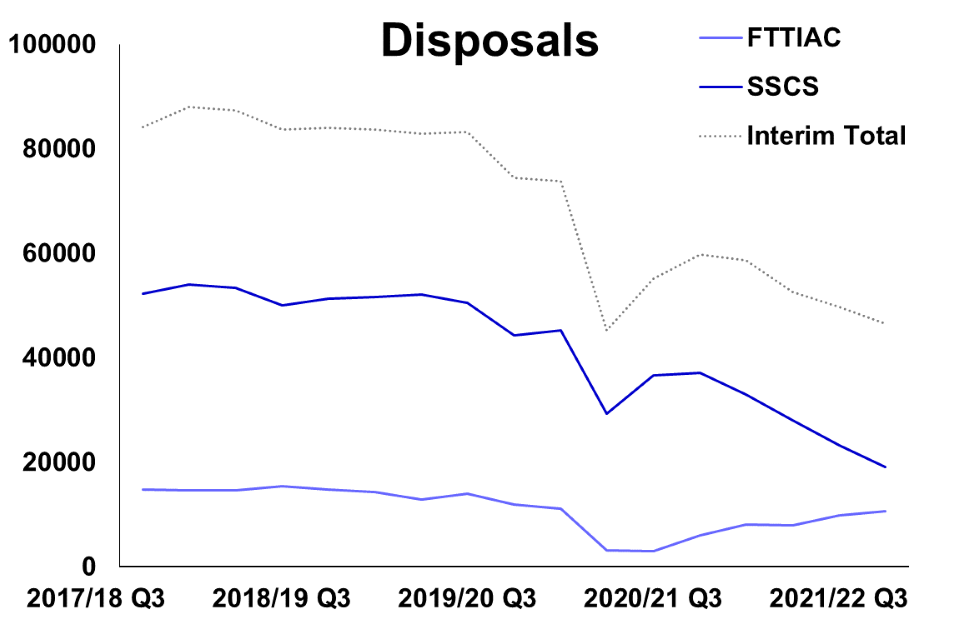
Figure 3.3: Caseload outstanding[footnote 2] interim totals, Q3 2017/18 to Q3 2021/22 (Source: Tables S_4)
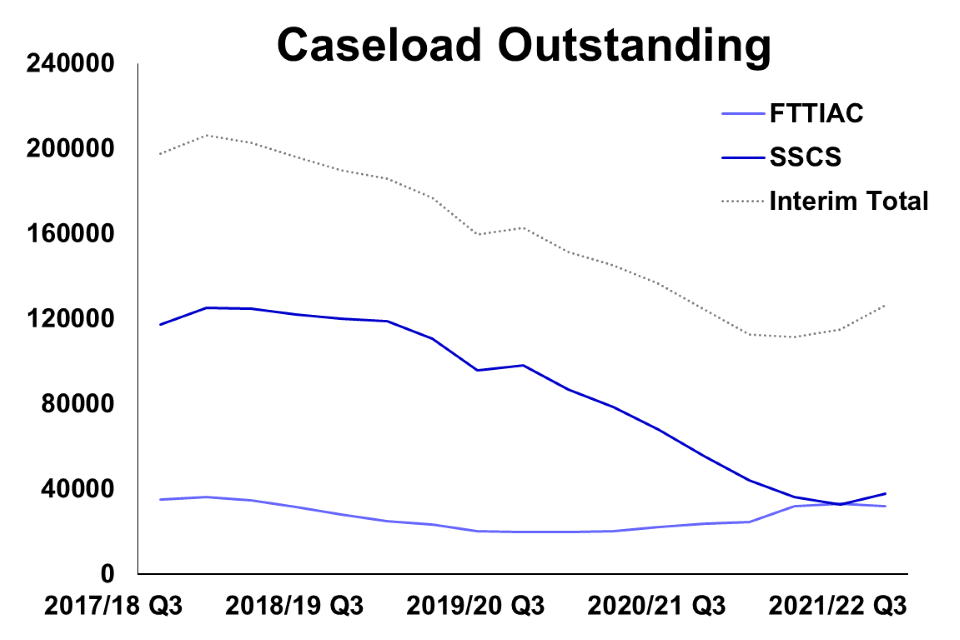
The charts above show the trends in receipts, disposals and caseload outstanding over the last five years for SSCS, FTTIAC and all tribunals overall (using the Interim Total measure). In October to December 2021, receipts increased by 28% compared to October to December 2020. This was driven by increases in FTTIAC, SSCS, and First-tier tax chamber, of 5%, 12%, and 742% respectively (to 8,200, 25,000, and 10,000 receipts respectively). This rise is largely due to case levels returning to normal following the impact of the COVID-19 pandemic and related government actions to mitigate the effects on society in the previous financial year.
Overall interim disposals decreased by 22% in October to December 2021 (to 47,000), compared to October to December 2020. Compared to Q3 2019/20, which was pre-COVID, the volume decreased by 37%. The FTTIAC disposed of 73% more cases in Q3 2021/22 compared to Q3 2020/21. The rise was offset by a 48% decrease in SSCS disposals. Compared to the same quarter in 2019, FTTIAC disposals decreased by 11%.
There were 126,000 cases outstanding across all Tribunals at the end of December 2021, an increase of 1% compared to a year ago. The 35% increase in FTTIAC caseload outstanding, was offset by a 32% decrease in SSCS caseload outstanding.
4. Social Security and Child Support
SSCS receipts increased and disposals and caseload outstanding decreased
SSCS receipts increased by 12% compared to the same period in 2020. Disposals and caseload outstanding decreased in the same period by 48% and 32% respectively.
61% of disposals were cleared at hearing with a 60% overturn rate
Of the 19,000 disposals in October to December 2021, 61% were cleared at a hearing and of these, 60% had the initial decision revised in favour of the claimant (down from 63% and 66% in the same period in 2020 respectively).
Figure 4.1: Social Security and Child Support receipts, Q3 2017/18 to Q3 2021/22 (Source: Tables SSCS_1)
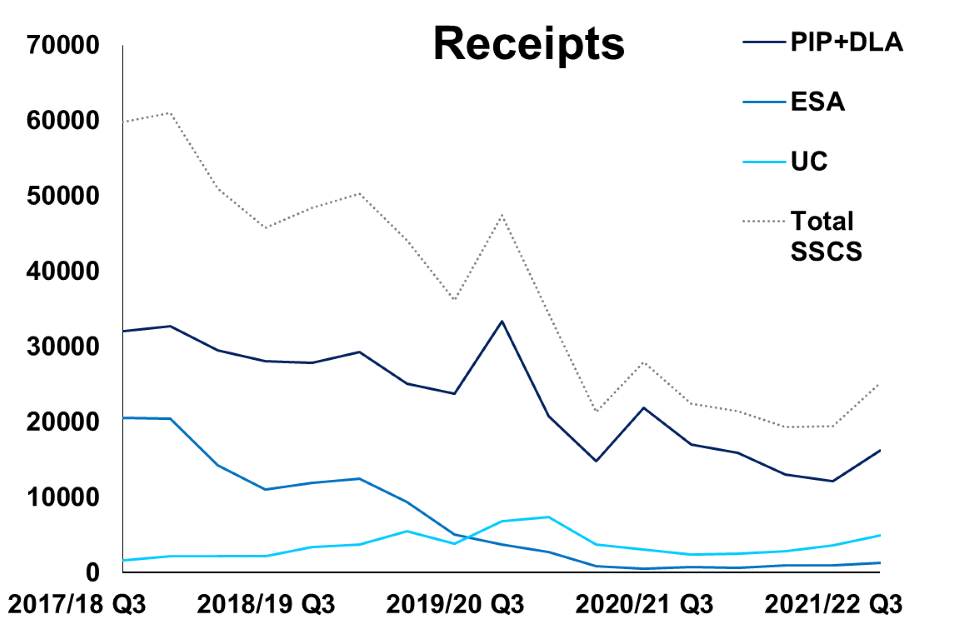
Figure 4.2: Social Security and Child Support disposals, Q3 2017/18 to Q3 2021/22 (Source: Tables SSCS_2)
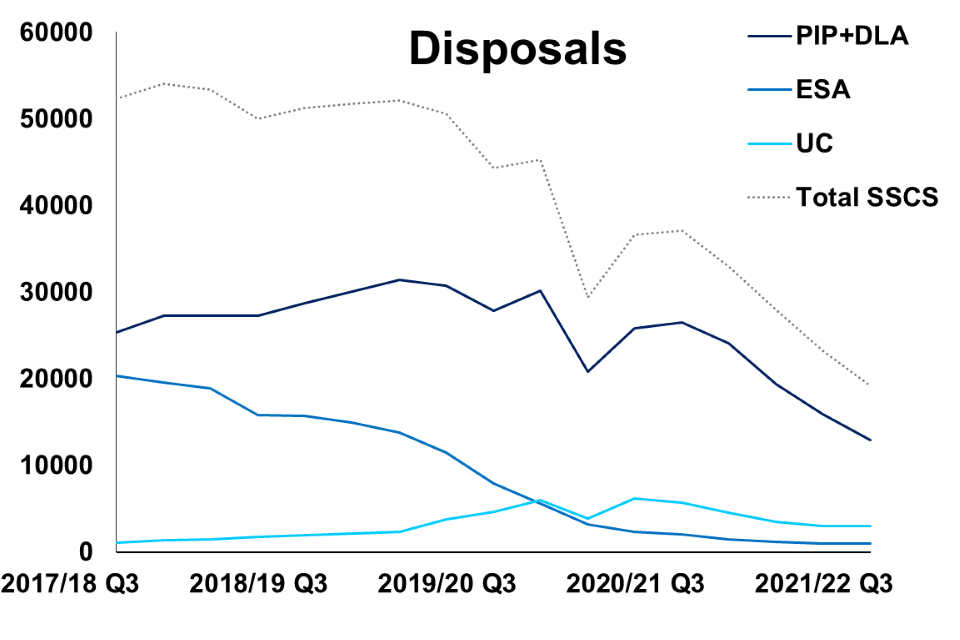
Figure 4.3: Social Security and Child Support caseload outstanding, Q3 2017/18 to Q3 2021/22 (Source: Tables S_4)
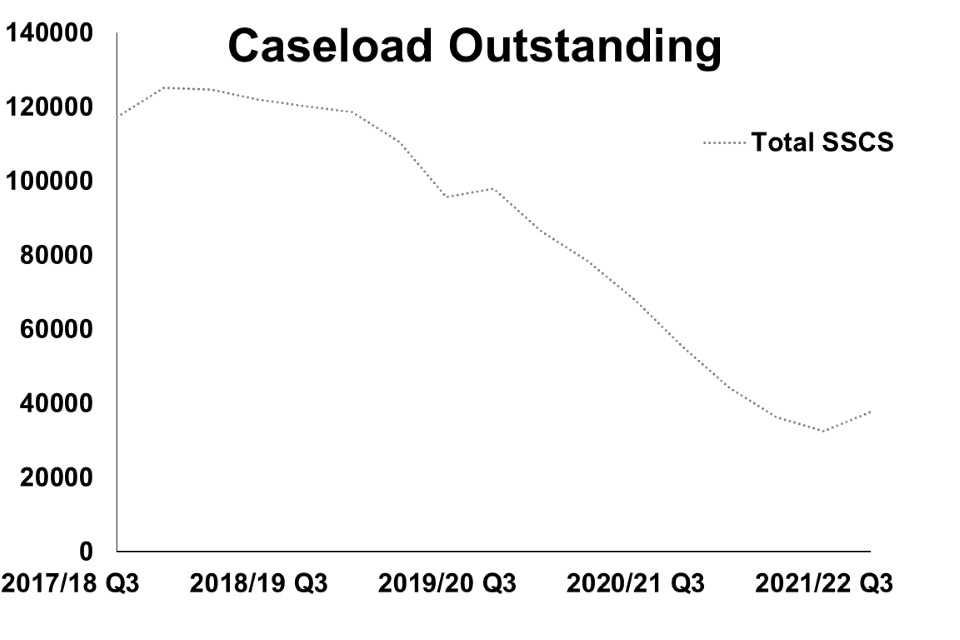
The economic impact of the COVID-19 pandemic resulted in an increase in the number of people on Universal Credit[footnote 3] as the employment rate decreased and economic inactivity increased. The Department for Work and Pensions (DWP) changes to benefit processes in response to the pandemic, such as the temporary suspension of face-to-face assessments for health and disability-related benefits, contributed to the general downward trend in receipts seen during the pandemic. However, as the policies put in place due to COVID-19 come to an end and restrictions are eased, we are now seeing SSCS receipts return to pre-COVID-19 levels.
Over the last quarter, there were increases in the employment rates and decreases in the unemployment rates and subsequently SSCS tribunal receipts have increased by 12% this quarter, to 25,000 appeals, compared to October to December 2020. This was driven by a 103% increase in Universal Credit (UC) receipts. UC appeals accounted for 20% of all SSCS receipts in October to December 2021. Universal Credit is available to people who are in work and on a low income, as well as to those who are out of work.
In October to December 2021, SSCS disposals decreased by 48% when compared with the same period in 2020 (from 37,000 in Q3 2020/21 to 19,000 in Q3 2021/22). PIP made up nearly two thirds of SSCS disposals (61%).
Of the disposals made by the SSCS Tribunal, 12,000 (61%) were cleared at hearing, and of these, 60% were overturned in favour of the customer (down from 63% and down from 66% on the same period in 2020 respectively). This overturn rate varied by benefit type, with PIP at 68%, Disability Living Allowance (DLA) 65%, Employment Support Allowance (ESA) 60%, and UC 46%. The PIP, DLA, ESA and UC overturn rates mostly decreased compared with October to December 2020 (PIP down 6%, DLA down 1%, ESA down 9% and UC down 11%).
There were 38,000 SSCS cases outstanding at the end of December 2021, a decrease of 32% compared to the same period in 2020. This continues the fall that began in Q4 2018/19 (when comparing to the same quarter in the previous year). However, comparing quarter-on-quarter, caseload outstanding increased slightly for the first time since Q3 2019/20.
Of those cases disposed of by the SSCS tribunal in October to December 2021, the mean age of a case at disposal was 25 weeks, a 5 week decrease than for the same period in 2020 (see tables T_2) and seven weeks less than the same period in 2019.
5. Immigration and Asylum
First-tier Tribunal Immigration and Asylum Chamber (FTTIAC)
In October to December 2021, FTTIAC receipts and disposals increased by 5% and 73% (to 8,200 and 11,000), compared to the same period in 2020.
In the same period, caseload outstanding also increased by 35% (to 32,000).
Figure 5.1: First-tier Tribunal Immigration and Asylum Chamber receipts, Q3 2017/18 to Q3 2021/22 (Source: Tables FIA_1)
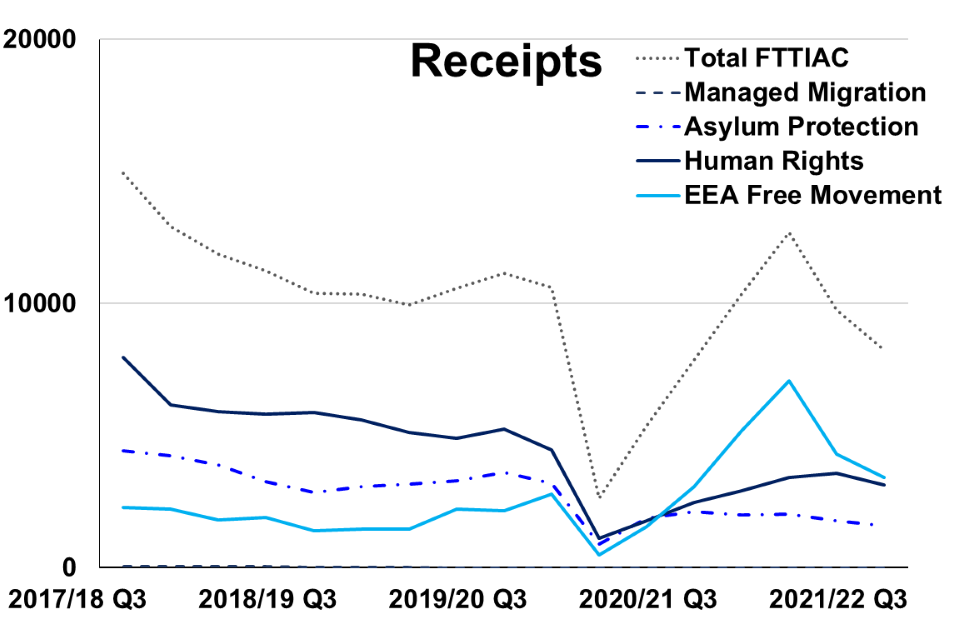
Figure 5.2: First-tier Tribunal Immigration and Asylum Chamber disposals, Q3 2017/18 to Q3 2021/22 (Source: Tables FIA_2)

Figure 5.3: First-tier Tribunal Immigration and Asylum Chamber caseload outstanding, Q3 2017/18 to Q3 2021/22 (Source: Tables S_4)
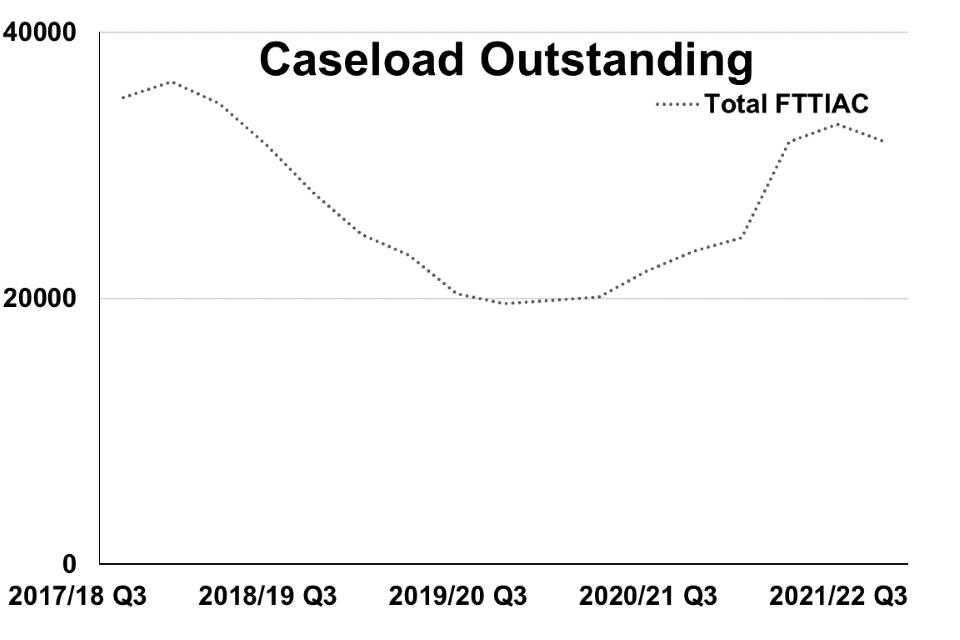
The main EU Settlement Scheme (EUSS) route closed on 30 June 2021. In October to December 2021, EEA/EUSS receipts proportionally represented 41% of all FTTIAC receipts (up from 39% a year ago). In Q3 2021/22 there was an 11% and 26% increase in EEA/EUSS and Human Rights (HR) receipts respectively (to 3,400 and 3,100 respectively), compared to the same period in 2020. Asylum/Protection (AP) receipts decreased by 25% compared to the same period in 2020 (to 1,600). HR and AP proportionally represented 38% and 19% of all FTTIAC receipts respectively (up 6 and down 8 percentage points respectively from a year ago).
Following on from a steep fall in 2020/21 due to the impact of the pandemic, this quarter there was a rise in FTTIAC receipts to 8,200. The rise was due to an increase in EEA/EUSS and Human Rights appeals.
The FTTIAC disposed of 11,000 appeals in October to December 2021, a 73% increase compared the same period in 2020. The Home Office has increased decision making activity as travel restrictions are lifted and visa centres in the UK and abroad resume normal service. This rise in disposals was driven by a 15%, 7% and 251% rise in HR, AP and EEA disposals respectively. EEA appeals made up the largest proportion (52%) of all FTTIAC disposals in October to December 2021, up from 26% a year ago.
Of the disposals made in the FTTIAC this quarter, 64% were determined i.e. a decision was made by a judge at a hearing or on the papers (compared to 79% in Q3 2019/20 and 57% in Q3 2020/21); 18% were withdrawn (compared to 18% in Q3 2019/20 and 27% in Q3 2020/21); 7% were struck out for non-payment of the appeal fee (compared to 2% in Q3 2019/20 and 4% in Q3 2020/21), and 2% were invalid or out of time (compared to 2% in Q3 2019/20 and 3% in Q3 2020/21). Half (50%) of the 6,700 cases determined at a hearing or on the papers were allowed/granted, although this varied by case type (50% of Asylum/Protection, 55% of Human Rights and 49% of EEA Free Movement appeals were allowed/granted).
The First-tier Tribunal Immigration and Asylum Chamber received 93 Deprivation of Citizenship receipts, a decrease of 3% compared to the same quarter last year, and an increase of 98% compared to the same quarter in 2019/20 (pre-COVID). Deprivation of Citizenship disposals increased by 89% compared to the same quarter last year (from 27 in Q3 2020/21, to 51 in Q3 2021/22) and by 113% compared to the same quarter in 2019/20.
In the FTTIAC, the mean time taken to clear appeals across all categories is at 39 weeks this quarter, which is 5 weeks less compared to the same period a year ago. Asylum/Protection, Human Rights and EEA Free Movement had mean times taken of 47 weeks, 45 weeks and 34 weeks respectively.
6. Gender Recognition Certificates
168 Gender Recognition Panel (GRP) applications were received and 128 were disposed of between October to December 2021; 394 applications were pending by the end of December 2021
GRP applications received this quarter increased to 168, an increase of 60 compared to October to December 2020. Of the 128 applications disposed of, a full Gender Recognition Certificate (GRC) was granted in 85% of cases (109 full GRCs), down 8 percentage points compared to the same period in 2020 (where 140 full GRCs were granted out of 151 disposals). GRP receipts have increased annually since 2017/18 and we expect this trend to continue following a reduction in the application fee in May 2021 from £140 to £5, and the move to an online application process. This has subsequently caused an increase in both the caseload outstanding and refusals. Caseload outstanding reached a high of 394 cases in Q3 2021/22, while 11% of all disposals (14 cases) have been refused. Applications can be refused if they do not meet the required criteria. More information on the criteria can be found at the following link: Apply for a Gender Recognition Certificate - GOV.UK (www.gov.uk).
Since April 2005/06, when the Gender Recognition Act 2004 came into effect, 71% of interim certificates (171 of the 241 interim GRCs granted) have been converted to a full GRC, 40% of which were converted within 30 weeks. One interim certificate was converted to a full GRC between October to December 2021.
Of the 109 full certificates granted in October to December 2021, 2 were for married applicants and 106 for single applicants (the marital status for the remaining applicant was ‘other’). 46 (42%) of the individuals granted full certificates were registered male at birth while 63 (58%) were registered female at birth.
Figure 6.1: Applications for Gender Recognition Certificates received, disposed of and pending, 2016/17 to 2020/21 (Source: Tables GRP_1 and GRP_2)

Figure 6.2: Full Gender Recognition Certificates granted by year of birth, 2016/17 to 2020/21 (Source: Table GRP_4)

7. Special Educational Needs and Disability (SEND)
There were 1,900 receipts and 2,200 disposals for the SEND tribunal in Q3 2021/22; 3,300 applications were outstanding at the end of the same quarter
The SEND tribunal receipts increased by 17% (to 1,900) in Q3 2021/22 when compared to the same quarter in 2020/21. SEND receipts have increased year-on-year since Q4 2015/16, reaching a peak of 3,400 in Q2 2021/22. SEND receipts fluctuate throughout the year, typically increasing in Q2 (July to September) due to the start of the academic year, as illustrated in Figure 7.1.
The number of SEND disposals increased by 10% (to 2,200) in October to December 2021 compared to October to December 2020. SEND disposals have increased year-on-year since Q3 2018/19 and are currently at their highest recorded level.
SEND caseload outstanding at the end of Q3 2021/22 increased by 17% (to 3,300) when compared to the end of Q3 2020/21.
Figure 7.1: Registered SEND appeals, Q3 2016/17 to Q3 2021/22 financial year (Source: Tables S_2, S_3 and S_4)
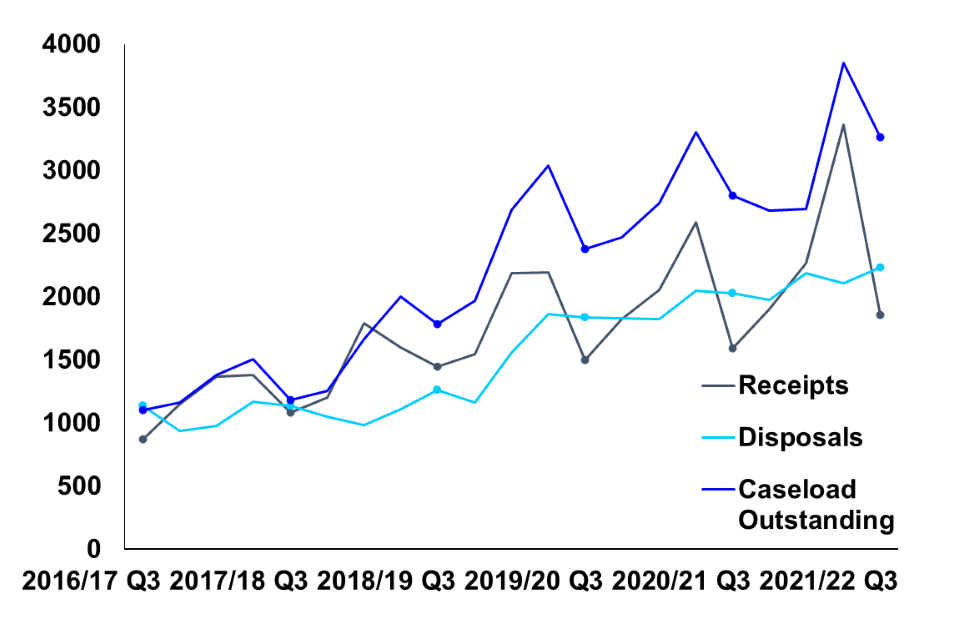
8. Other Tribunals
Increase in First-tier tax Chamber receipts by 742% compared to the same quarter last year
The First-tier Tax Chamber recorded 10,000 receipts this quarter, an increase of 742% compared to the same quarter last year. In the same period, 2,000 appeals were disposed of and caseload outstanding increased by 45% (to 38,000).
Mental Health receipts and disposals decreased and caseload outstanding increased compared to 2020/21
Mental health receipts and disposals decreased and when compared to October to December 2020, with receipts down by 2%, disposals down by 5%. Compared to the same period last year, caseload outstanding increased by 1%.
First-tier Tax Chamber
There has been an increase in all case types in the First-tier Tax Chamber this quarter. Receipts increased by 742%, to 10,000, compared to the same quarter last year. This is the highest number of receipts seen in any one quarter since 2009. Disposals and caseload outstanding also increased by 5% and 45% to 2,000 and 38,000 respectively. This trend started in Q2 2021/22 and is likely to continue as Treasury and HMRC increase action against umbrella companies employing potentially fraudulent VAT schemes.
Figure 8.1: First-tier Tax Chamber receipts, disposals and caseload outstanding Q3 2017/18 to Q3 2021/22 (Source: Tables S_2, S_3, and S_4)
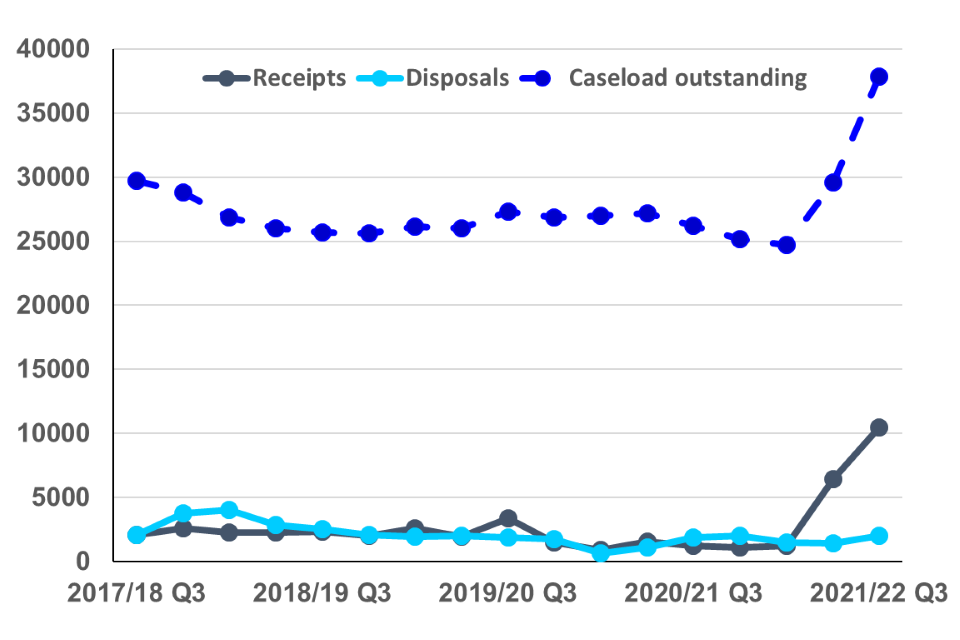
Mental Health
Mental health figures have remained stable this quarter. Receipts decreased by 2% in October to December 2021 (to 7,700), compared to the same period in 2020, and in 2019/20, which was pre-COVID, the volume decreased by 6%. The tribunal disposed of 8,000 appeals in Q3 2021/22, a decrease of 5% and 7% when compared to Q3 2020/21 and Q3 2019/20 respectively. There were 3,500 Mental Health cases outstanding at the end of December 2021, up 1% compared to the same period in 2020. The mean age of cases at clearance for the Mental Health section 2, Mental Health Restricted Patients, and the Mental Health Non-Restricted Patients case types has remained consistent for the same period in the last couple of years at 1, 12 and 6 weeks respectively.
Nitrates Vulnerable Zones (NVZ)
From April 2016, the Tribunal hears appeals against the designation of NVZs by the Department for Environment, Food and Rural Affairs (DEFRA). The Tribunal is quadrennial and hears appeals in relation to NVZ notices issued once every four years to landowners by DEFRA. The Nitrates Vulnerable Zones appeals are now live again and are reporting figures. In Q3 2021/22, there were 36 receipts and 5 disposals for the Nitrates Vulnerable Zones tribunal. At the end of December 2021, there were 31 cases outstanding. These figures are significantly lower than those seen in Q4 2016/17, which is the first quarter the tribunal was made live four years ago, with receipts 72% lower, disposals 88% lower, and caseload outstanding 64% lower than Q4 2016/17 figures.
9. Further information
Rounding convention
Figures greater than 10,000 are rounded to the nearest 1,000, those between 1,000 and 10,000 are rounded to the nearest 100 and those between 100 to 1,000 are rounded to the nearest 10. Less than 100 are given as the actual number.
Accompanying files
As well as this bulletin, the following products are published as part of this release:
-
A supporting document providing further information on how the data is collected and processed, as well as information on the revisions policy and legislation relevant to trends and background on the functioning of the tribunal system.
-
The quality statement published with this guide sets out our policies for producing quality statistical outputs for the information we provide to maintain our users’ understanding and trust.
-
A set of overview tables, covering each section of this bulletin.
-
A set of CSV files including data on two of the three large tribunals (SSCS and Immigration and Asylum) and an overall receipts and disposals CSV, covering all tribunal types.
-
Additional releases this quarter:
- Update to the statistical notice on Immigration and Asylum (I&A) Detained Immigration Appeals (DIA) to include data to Q3 2021/22.
Future publications
Our statisticians regularly review the content of publications. Development of new and improved statistical outputs is usually dependent on reallocating existing resources. As part of our continual review and prioritisation, we welcome user feedback on existing outputs including content, breadth, frequency and methodology. Please send any comments you have on this publication including suggestions for further developments or reductions in content.
Contact
Press enquiries should be directed to the Ministry of Justice or HMCTS press office:
Daniel Mulloy - email: Daniel.Mulloy@Justice.gov.uk
Other enquiries and feedback on these statistics should be directed to the Data and Evidence as a Service division of the Ministry of Justice:
Rita Kumi-Ampofo or Tess Williams - email: CAJS@justice.gov.uk
Next update: 9 June 2022 (URL: www.gov.uk/government/collections/tribunals-statistics)
© Crown copyright Produced by the Ministry of Justice
For any feedback on the layout or content of this publication or requests for alternative formats, please contact CAJS@justice.gov.uk
-
The interim totals for the overall volumes of tribunal receipts, disposals and caseload outstanding exclude the Upper Tribunal (Immigration and Asylum Chamber), UTIAC Judicial Review, Employment Tribunal and Employment Appeal Tribunal for which the data is currently not available. See the main tables S_2, S_3 and S_4 for more information. ↩ ↩2 ↩3 ↩4 ↩5 ↩6 ↩7 ↩8 ↩9 ↩10 ↩11 ↩12
-
Outstanding caseload is based on a snapshot in time based on the last day of each quarter. ↩
-
Official statistics overview: Universal Credit statistics - GOV.UK (www.gov.uk) ↩
